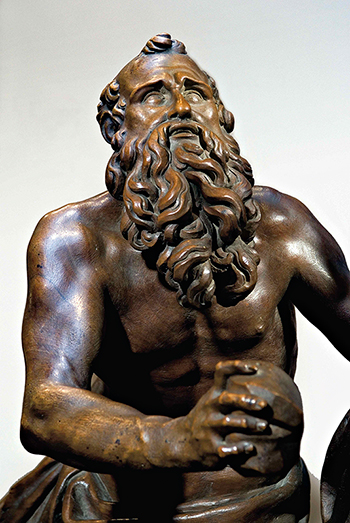The Romanist sculptor Juan de Anchieta
By Pedro Luis Echeverría Goñi
|
|
MAIN ALTARPIECE OF THE PARISH CHURCH OF SANTA MARÍA DE CÁSEDA |
|
|
|
|
|
|
|
|
|

|
|

|
|

|
|

|
Carving of Saint Jerome Penitent. Museum of Navarra
The technical quality of this group, from the cathedral, would be sufficient to assign it to the unmistakable gouge of Juan de Anchieta, but it is also documented as his "workmanship". It was carved in walnut wood in 1577-1578, together with the Crucified of the Barbazana, shortly before he joined the brotherhood of St. Joseph and St. Thomas, which grouped all the woodworkers and was based in its chapel in the cathedral. These two works were his cover letter before the chapter of the cathedral, after which the bishops and several of his vicars and other dignitaries would become his main clients. The Basque sculptor had previously treated this iconography in the altarpieces of Santa Clara de Briviesca or the Zaporta chapel of the Cathedral of Zaragoza.
However, here he proposes a different model , genuflecting with both knees supported, as we see in a drawing by Michelangelo in the Louvre Museum, and turned to one side with a "heavenly gaze", learned from his master Juan de Juni in Valladolid. He appears as a bald old man with the characteristic tuft and bushy beard, in declamatory attitude holding the stone with which he beat his chest in his left hand, and the other hand open and resting on the trunk on the canvases. During the Counter-Reformation, the figure of the hermit saint is promoted as an example of repentance and penance, above his condition of Doctor of the Church and author of the Vulgate, the Latin version of the Bible, which, for this reason, appears here below his knee next to the cardinal's capelet, which he never was. Thus, this dignity remains in the background, as well as the cloak he has been stripped of, which appears gathered on the dry trunk. The lion from which he removed a thorn, according to the Golden Legend, stands at his feet like a lapdog and raises his head to direct our gaze towards the saint.
In order to exalt the entity of this giant of Christianity, Anchieta represented an old man with a powerful Anatomy unbecoming of his age and a detailed study of face, hands, feet, bones, muscles, tendons and veins. Among the muscular planes, the treatment of the back stands out, showing the knowledge of Anatomy treatises and, through drawings, of classical statuary and, more specifically, of the so-called Torso of Belvedere, discovered in Rome at the beginning of the 16th century, which inspired Michelangelo for a sketch of the Battle of Cascina.
It adopts a scalene triangle outline and, as an archetypal Mannerist work, it offers multiple points of view to those surrounding the work, although the frontal is always considered the main one. The Italian sculptor and treatise writer Benvenuto Cellini affirmed that every sculpture has at least eight points of view, the four sides and the four angles that, in turn, admit other combinations among them. This theory led him to conclude that sculpture is seven times better than painting, which admits only one point of view.
Despite being blank and lacking color, the technical quality of the sculptor and the polishing, which are like "chromatic equivalents", makes it possible to distinguish each surface perfectly by its texture. To the rock floor and the gnarled walnut trunk, we add here the capelet or hat lined with cords pending with tassels, the Vulgata or book with bound covers, its sheets of paper, the leather strap like a cincture with which the cloth with frayed edges is tied to his waist, and the other trunk with bark on which he is half leaning, although the most prodigious work is the one with the saint's beard and the lion's mane.
CABEZUDO ASTRAIN, J., "Church of Santa María de Tafalla", Príncipe de Viana, 67-68 (1957), pp. 426-431.
CAMÓN AZNAR, J., El escultor Juan de Anchieta, San Sebastián, Diputación Foral de Guipúzcoa, 1943.
ECHEVERRÍA GOÑI, P. L. and VÉLEZ CHAURRI, J. J., "López de Gámiz and Anchieta compared. Las claves del Romanismo norteño", Príncipe de Viana, 185 (1988), pp. 477-534.
GARCÍA GAINZA, M.ª C., "El retablo de Añorbe y el arte de la Contrarreforma", in La recuperación de un patrimonio. El retablo mayor de Añorbe, Pamplona, Caja de Ahorros de Navarra, 1995, pp. 4-18.
GARCÍA GAINZA, M.ª C., Juan de Anchieta, sculptor of the Renaissance, Madrid, Fundación Arte Hispánico, 2008.
GARCÍA GAINZA, M.ª C., La escultura romanista en Navarra. Disciples and followers of Juan de Anchieta, 2nd ed., Pamplona, Government of Navarra, 1982.
GOYENECHE VENTURA, M.ª T., "La obra de Juan de Anchieta en la iglesia parroquial de Santa María de Cáseda (Navarra)", Príncipe de Viana, 185 (1988), pp. 535-562.
TARIFA CASTILLA, M.ª J., "Los modelos y figuras del escultor romanista Juan de Anchieta", in Fernández Gracia, R. (coord..), Pvlchrvm Scripta varia in honorem M.ª Concepción García Gainza, Pamplona, Gobierno de Navarra-Universidad de Navarra, 2011, pp. 782-790.
VASALLO TORANZO, L., Juan de Anchieta. Aprendiz y oficial de escultura en Castilla (1551-1571), Valladolid, Universidad de Valladolid, Secretariado de Publicaciones e exchange publishing house , 2012.






